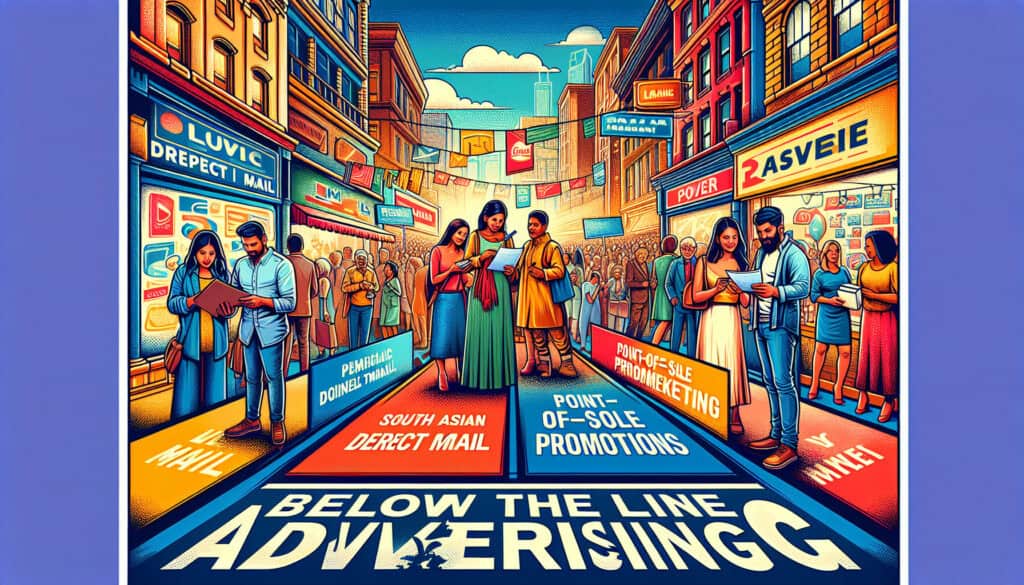A type of advertising that uses non-mass media channels to promote a product or service.
- Méthodologies : Lean Sigma, Fabrication
Below the Line (BTL) Advertising

Below the Line (BTL) Advertising
- Stratégies de marque, Expérience client, Cartographie de l'itinéraire du client, Marketing numérique, Commercialisation, Gestion de produits, Positionnement du produit, Public cible
Objectif :
Comment il est utilisé :
- BTL advertising includes activities such as direct mail, email marketing, and sales promotions. It is used to target specific groups of consumers with a personalized message.
Avantages
- Is a cost-effective way to reach a specific target audience, can be used to build relationships with customers, and can be used to generate immediate sales.
Inconvénients
- Can be difficult to measure the effectiveness of BTL campaigns, can be seen as intrusive by consumers, and may not be suitable for all types of products or services.
Catégories :
- Clients et marketing
Idéal pour :
- Targeting specific groups of consumers with a personalized marketing message.
Below the Line (BTL) advertising encompasses a range of strategies that can be seamlessly integrated into various project phases, particularly during the implementation and sales stages of product design and development. Industries such as consumer goods, technology, and healthcare utilize BTL techniques to engage distinct consumer segments, customizing communications to enhance relevance and reaction rates. For instance, a technology company launching a new gadget might use personalized email marketing to inform early adopters about exclusive pre-order options, while a skincare company could employ direct mail to send samples tailored to specific skin types. This methodology also extends to event marketing, where contests or promotions at trade shows can create direct, memorable interactions with potential customers. BTL advertising is particularly advantageous when targeting niche markets, as it allows for precise allocation of marketing budgets, optimizing the cost-to-reach ratio. Key participants in executing BTL strategies often include marketing teams, data analysts, and creative professionals, each contributing to the design and delivery of tailored messages that resonate with the audience. The interactive nature of these campaigns encourages feedback and dialogue, which can form the foundation for long-term customer relationships and improved product offerings. An example is a restaurant chain using loyalty programs to reward repeat customers with personalized discounts based on their previous orders or visits, thereby driving engagement and revenue.
Principales étapes de cette méthodologie
- Identify target audience segments for personalized messaging.
- Develop customized marketing materials tailored to each segment.
- Determine the optimal channels for direct outreach (e.g., email, direct mail).
- Implement campaigns across selected channels, ensuring consistent messaging.
- Monitor campaign responses and conduct follow-up outreach as needed.
- Analyze feedback and adjust future campaigns based on performance metrics.
Conseils de pro
- Utilize predictive analytics to better understand consumer behavior and preferences, enabling more accurate targeting and personalization.
- Incorporate multichannel strategies to enhance message consistency and frequency across different platforms, increasing engagement opportunities.
- Employ A/B testing methods on creative content and offers to identify which elements yield higher response rates among target segments.
Lire et comparer plusieurs méthodologies, nous recommandons le
> Référentiel méthodologique étendu <
ainsi que plus de 400 autres méthodologies.
Vos commentaires sur cette méthodologie ou des informations supplémentaires sont les bienvenus sur le site web de la Commission européenne. section des commentaires ci-dessous ↓ , ainsi que toute idée ou lien en rapport avec l'ingénierie.
Contexte historique
1960
1980
1983
1990
1995
2000
2010
1950
1980
1980
1986
1994
1995
2000
(si la date est inconnue ou n'est pas pertinente, par exemple "mécanique des fluides", une estimation arrondie de son émergence notable est fournie)














Articles Similaires
Gestion des opérations de fabrication (MOM)
Système d'exécution de la fabrication (MES)
Plan de contrôle de la fabrication
Tests manuels
Tableaux d'évaluation des manutentions manuelles (MAC)
ManTRA (outil d'évaluation des risques liés aux tâches manuelles)